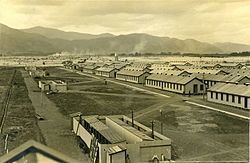 | ||
Featherston prisoner of war camp was a camp for captured Japanese soldiers during World War II at Featherston, New Zealand, notorious for a 1943 incident in which 48 Japanese and one New Zealander were killed. The camp had been established during World War I as a military training camp.
Contents
It had also been used as an internment camp from 1918 to 1920, when 14 German internees remained there.
Background
At the request of the United States, in September 1942 the Army camp at Featherston was re-established as a P.O.W. camp. The first commandant was Major R. H. Perrett. He was succeeded by Lieutenant Colonel D.H. Donaldson in mid December, 1942. Medical services were provided by a 40-bed hospital, which saw its first patient on 24 April 1943. About 900 prisoners from the Guadalcanal Campaign were housed at the camp, many of them conscripts. The senior Japanese officer at the Camp was Lieutenant S Kamikubo of the Imperial Japanese Navy.
The prisoners consisted of two groups; the larger group were Koreans and members of forced labour units who had been working at Henderson Field (Guadalcanal), and the smaller group consisted of about 240 officers and other ranks of the Imperial Japanese Army, Navy, and Air Force. The majority of this second group were crew from the Japanese cruiser Furutaka, which was sunk during the Battle of Cape Esperance. The 19 surviving crew of the destroyer Akatsuki were also imprisoned here.
Camp
The camp itself was divided into four compounds, with the Koreans and labourers in one, the sailors in the second, and the officers and others in the third and fourth compounds. The prisoners lived in small army huts - 8 men to one hut.
The officers were given New Zealand battledress, dyed blue to wear and a conventional hat, also dyed blue. The other ranks were given blue dyed World War One uniforms with a diamond shaped khaki patch sown on the back of the jacket and the front and back of the right thigh of the trousers. Boots were also provided.
Riot
The camp's most infamous event was on 22 February 1943 during a sit-in of 275 prisoners in the second compound, who refused to work. The exact sequence of events is disputed, but a Japanese Lieutenant named Adachi was shot and wounded by the camp adjutant. This led to the prisoners either charging or appearing to charge the guards, who opened fire with rifles, sub-machine guns and pistols. Fifty seconds later 46 prisoners were dead, with another 18 dying later of their injuries, and 94 wounded. On the New Zealand side, a ricochet from a burst of the gunfire killed Private Walter Pelvin, and several other soldiers were injured by rocks; six others were wounded.
A military court of enquiry put the majority of blame for the incident on the prisoners, but found that there were cultural differences in the camp, which led to the deadly actions and needed to be addressed. Among the issues was that the Japanese did not know that under the 1929 Geneva Convention on Prisoners of War, compulsory work was allowed. The event remains a testimony to cultural misunderstanding for the Featherston community today.
Camp life
Each of the four compounds had its own leader and they in turn had assistants under them. The leaders were responsible for their compound's order and cleanliness, along with organising personnel for specific tasks. The leaders also communicated any of the prisoners complaints or concerns to the Camp Commander.
The prisoners constructed a memorial inscribed in Japanese to their faithful dead in front of one of the huts. The memorial was described as a very fine piece of work and made of reddish stone. The base was made of stones inlayed in concrete with a rough oblong block of stone with a smoothed face panel as its tablet. This panel had the Japanese inscription.
Outside most huts the prisoners cultivated small gardens, growing flowers and by vegetables. Some prisoners made tennis court in one area, levelling the ground and making the nets and rackets from scrap materials. Mahjong sets were also carved from wood. Movies were shown about once a fortnight for entertainment and some of the prisoners put on traditional costume plays in the recreation huts.
The prisoners did not wear their shoes or boots in the huts, but constructed a small storage area inside the huts entrance for them. Some made curtains for the lower bunks from scrap material and some made small lockers for their personal effects.
Repatriation
As the end of the war neared, the prisoners began to worry about their future position in Japanese society. A Press article stated that to their own people they were considered dead. In September 1944 the prisoners told a neutral inspector that provision needed to be made for them to return as honourable citizens, or that they be given asylum on a Pacific island. They said if something could not be done mass suicide might result. After the end of the war they also worried that they could be attacked in New Zealand over the conditions of Japanese prisoner of war camps.
The prisoners were transported in two trains from Featherston to Wellington and embarked on 30 December 1945, travelling to Japan on two large American tank landing ships, LST 273 and LST 275, which were under Lieutenant Commander R P Rudolph. The ships stopped at Guadalcanal on the return journey where the Japanese held a ceremony to remember their dead companions. They disembarked at Uraga, Kanagawa on 4 February 1946.
